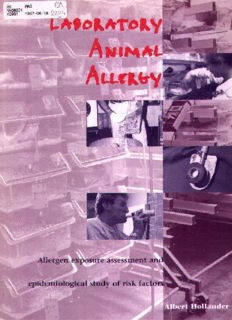Table Of Contente
39 HAG
NN08201
•
22-3*1 J
40951 1997-C6-18
A N I MA
STELLINGEN
1. De mate van blootstelling aan luchtwegallergenen, afkomstig van proefdieren,
bepaalt de kans op het ontstaan van een proefdierallergie.
Dit proefschrift.
2. Een allergie voor huisdieren is een belangrijke indicator voor een verhoogde kans
op het ontwikkelen van een proefdierallergie.
Dit proefschrift.
3. Een aanzienlijke reductie van de allergeenblootstelling is nodig om het aantal
nieuwe gevallen van proefdierallergie tot een aanvaardbaar aantal terug te brengen.
4. Een aanzienlijke reductie van de allergeenblootstelling in proefdiercentra is alleen
mogelijk wanneer werkgevers, werknemers en overheid inzien dat proefdierallergie
een belangrijk gezondheidsprobleem is, dat wordt veroorzaakt door het werken met
proefdieren.
5. De uitspraak 'Substantial risks can no longer be expected in occupational
epidemiological studies', geldt zeker niet voor studies naar beroepsallergieën.
Wegman DH. Issues in the epidemiologie evaluation of exposure-response relationships.
In: Rappaport SM, Smith TJ, eds. Exposure assessment for epidemiology and hazard
control. Chelsea, MI, US: Lewis, 1991:159-174.
6. De recente organisatie van een symposium door de Nederlandse Vereniging van
Arbeidshygiëne met als centraal thema de wettelijke aansprakelijkheid bij het
verlenen van professioneel advies, doet vermoeden dat de commercialisering van
de Arbodiensten een negatief effect heeft gehad op de kwaliteit van het door de
arbodeskundigen gegeven advies.
7. Door aparte inzameling van GFT (groente, fruit en tuin) afval, stoft het overige
afval veel meer dan vroeger.
Een werknemer van een overlaadstation.
8. De capaciteit van AMV Reverse Transcriptase om bij een temperatuur van
tenminste 58°C zijn activiteit te behouden, vergroot de mogelijkheden om
complexe RNA moleculen met behulp van RT-PCR te analyseren.
Dr. ir. C.C.M. van Oers, mondelinge communicatie.
9. Het idee heerst dat wij een sterke greep hebben op de natuur, maar in werkelijkheid
is er sprake van een houdgreep.
10. Blank of gekleurd, arm of rijk, gehandicapt of niet, kinderen maken geen
onderscheid, dat doen hun ouders voor ze.
11. Alhoewol by de Alvestêdetocht mar ien de earste wêze kin op de Bonke, binne alle
reedriders dy folgje winners.
Alhoewel bij de Elfstedentocht maar één als eerste op de Bonkevaart over de streep
kan gaan, zijn alle schaatsers die volgen winnaars.
12. Het is jammer dat het nut van een goed georganiseerde en uitgeruste KNRM
(Koninklijke Nederlandse Redding Maatschappij) door velen pas wordt ingezien
nadat een beroep op haar diensten moest worden gedaan.
Stellingen behorende bij het proefschrift 'Laboratory Animal Allergy, allergen exposure
assessment and epidemiological study of risk factors'.
Albert Hollander, Wageningen, 23 juni 1997
LABORATORY ANIMAL ALLERGY
ALLERGEN EXPOSURE ASSESSMENT AND
EPIDEMIOLOGICAL STUDY OF RISK FACTORS
ALBERT HOLLANDER
CENTRALE
Promotoren: dr. ir. B. Brunekreef
Hoogleraar in de Gezondheidsleer, meer in het bijzonder de relatie
tussen milieu, arbeid en gezondheid
Landbouwuniversiteit Wageningen
P. Malmberg, M.D. PhD.
Director of the Department of Occupational Health of the National
Institute for Working Life and professor linked to the Karolinska
Institute, Solna, Sweden
Co-promotor: dr. ir. D.J.J. Heederik
Hoofddocent vakgroep Humane Epidemiologie en Gezondheidsleer
Landbouwuniversiteit Wageningen
ALBERT HOLLANDER
LABORATORY ANIMAL ALLERGY
ALLERGEN EXPOSURE ASSESSMENT AND
EPIDEMIOLOGICAL STUDY OF RISK FACTORS
Proefschrift
ter verkrijging van de graad van doctor
op gezag van de rector magnificus
van de Landbouwuniversiteit te Wageningen,
dr. CM. Karssen
in het openbaar te verdedigen
op maandag 23 juni 1997
des namiddags te vier uur in de Aula.
The study presented in this thesis was supported by research grants from the
Netherlands Asthma Foundation, the Ministry of Social Affairs and Employment and
the European Union (contract no. BMH1-CT94-1446).
BIFUOTHrO":
í iKíJuwin .T:A ,..-.F
Omslag: ontwerp van Alces alces, Utrecht
Druk: Grafisch Bedrijf Ponsen & Looijen B.V., Wageningen
ISBN: 90-5485-701-3
VOOREEF
ABSTRACT
The main objective of the study presented in this thesis was to estimate the prevalence
rate of laboratory animal allergy and to determine its association with risk factors, like
allergen exposure level, atopy, gender and other host factors. A cross-sectional survey
was undertaken among 540 workers at 8 laboratory animal facilities. All participants
completed a questionnaire and underwent skin prick testing with common and occupa
tional allergens. Total and specific IgE measures were obtained. Prevalence rates of
allergic symptoms (chest tightness (asthma), eye/nose and/or skin) due to working
with rats or mice were 19% and 10%, respectively. The most common symptoms were
eye/nose symptoms, 17% and 9% and asthmatic symptoms were found in 6% and 3%
of the workers, respectively. The prevalence rate of sensitisation to rat or mouse
allergens was 18% and 11%. Symptoms and sensitisation were strongly correlated.
However, not all symptoms seemed to be IgE mediated. Rat and mouse allergy, defi
ned as allergic symptoms accompanied by sensitisation, was highly associated with
elevated total IgE (^ 100 kU/1) and positive skin prick response to common allergens.
The relationship between rat and mouse allergy and positive skin prick response to
common allergens, could be completely explained by a specific response to cat or dog
fur allergens.
Stationary and personal air sampling was performed to identify determinants of
exposure and estimate the animal allergen exposure. Animal caretakers experienced
the highest exposure to aeroallergens. However, large variation within each job title
was present. This may result from the wide range of tasks performed, of which
handling contaminated bedding or conscious rats or mice showed the highest exposu
re. A relationship between allergen exposure and rat allergy became visible after
excluding workers with four or more years of exposure to laboratory animals. This
relationship was clearly visible for the atopic workers (having an pet allergy and/or
elevated total serum IgE). The effect of exposure on rat allergy varied between atopic
and non-atopic workers. Atopy should therefore be considered as an effect modifier of
exposure. A higher prevalence rate of rat allergy was also found for men and smokers.
However, these associations were not statistically significant.
Description:Exposure of laboratory animal workers to airborne rat and. 15 studies, but also because exposure can be a subject of environmental control. Recent.

